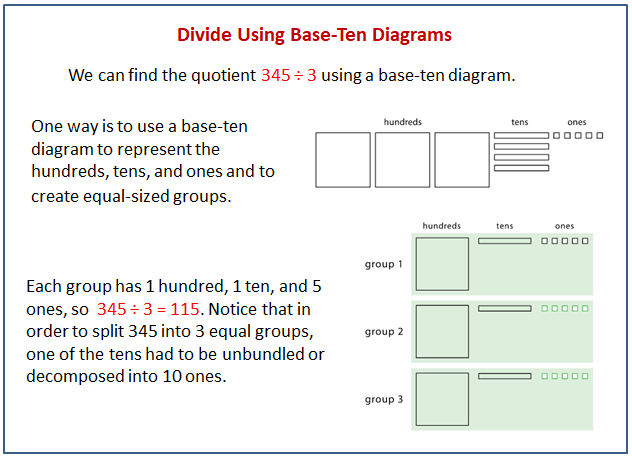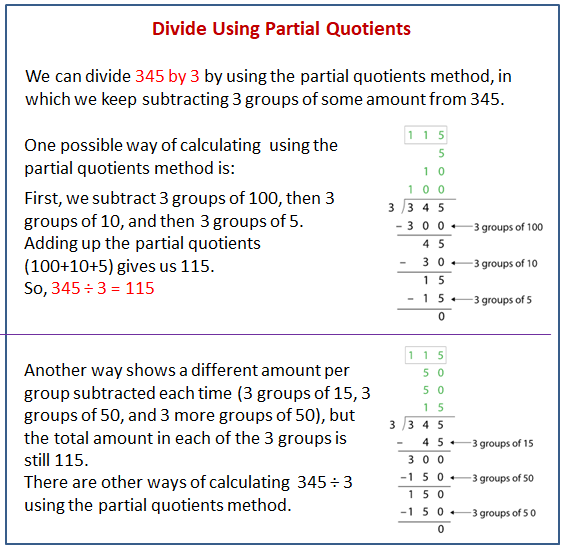Illustrative Mathematics Unit 6.5, Lesson 9: Using the Partial Quotients Method
Learning Targets:
- I can use the partial quotients method to find a quotient of two whole numbers when the quotient is a whole number.
Related Pages
Illustrative Math
Grade 6
Lesson 9: Using the Partial Quotients Method
Let’s divide whole numbers.
Illustrative Math Unit 6.5, Lesson 9 (printable worksheets)
Lesson 9 Summary
We can find the quotient in different ways.
The following diagram shows how to use base-ten diagrams to find a quotient of two whole numbers when the quotient is a whole number.

The following diagram shows how to use the partial quotients method to find a quotient of two whole numbers when the quotient is a whole number.

Both the base-ten diagrams and partial quotients methods are effective. If, however, the dividend and divisor are large, then the base-ten diagrams will be time-consuming.
Lesson 9.1 Using Base-Ten Diagrams to Calculate Quotients
Elena used base-ten diagrams to find 372 ÷ 3. She started by representing 372.
She made 3 groups, each with 1 hundred. Then, she put the tens and ones in each of the 3 groups. Here is her diagram for 372 ÷ 3.
Discuss with a partner:
- Elena’s diagram for 372 has 7 tens. The one for 372 ÷ 3 has only 6 tens. Why?
- Where did the extra ones (small squares) come from?
Lesson 9.2 Using the Partial Quotients Method to Calculate Quotients
- Andre calculated 657 ÷ 3 using a method that was different from Elena’s.
Discuss the following questions with a partner:
- Andre subtracted 600 from 657. What does the 600 represent?
- Andre wrote 10 above the 200, and then subtracted 30 from 57. How is the 30 related to the 10?
- What do the numbers 200, 10, and 9 represent?
- What is the meaning of the 0 at the bottom of Andre’s work? 2.How might Andre calculate 896 ÷ 4? Explain or show your reasoning.
Lesson 9.3 What’s the Quotient?
- Find the quotient of 1,332 ÷ 9 using one of the methods you have seen so far. Show your reasoning.
- Find each quotient and show your reasoning. Use the partial quotients method at least once.
a. 1,115 ÷ 5
b. 665 ÷ 7
c. 432 ÷ 16
Lesson 9 Practice Problems
- Here is one way to find 2,105 ÷ 5 using partial quotients.
Show a different way of using partial quotients to divide 2,105 by 5. - Andre and Jada both found 657 ÷ 3 using the partial quotients method, but they did the calculations differently, as shown here.
a. How is Jada’s work similar to and different from Andre’s work?
b. Explain why they have the same answer. - Which might be a better way to evaluate 1,150 ÷ 46: drawing base-ten diagrams or using the partial quotients method? Explain your reasoning.
- Here is an incomplete calculation of 534 ÷ 6.
Write the missing numbers (marked with “?”) that would make the calculation complete. - Use the partial quotients method to find 1,032 ÷ 4.
- Which of the polygons has the greatest area?
A. A rectangle that is 3.25 inches wide and 6.1 inches long.
B. A square with side length of 4.6 inches.
C. A parallelogram with a base of 5.875 inches and a height of 3.5 inches.
D. A triangle with a base of 7.18 inches and a height of 5.4 inches. - One micrometer is a millionth of a meter. A certain spider web is 4 micrometers thick. A fiber in a shirt is 1 hundred-thousandth of a meter thick.
a. Which is wider, the spider web or the fiber? Explain your reasoning.
b. How many meters wider?
The Open Up Resources math curriculum is free to download from the Open Up Resources website and is also available from Illustrative Mathematics.
Try the free Mathway calculator and
problem solver below to practice various math topics. Try the given examples, or type in your own
problem and check your answer with the step-by-step explanations.

We welcome your feedback, comments and questions about this site or page. Please submit your feedback or enquiries via our Feedback page.